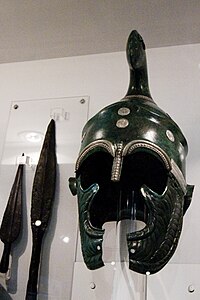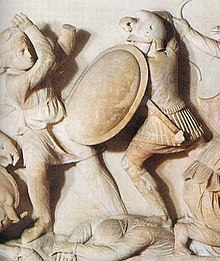|
Constantius Gallus – Roman Caesar:
351-354 A.D. –
Bronze AE2 22mm (6.36 grams) Alexandria mint: 351-354 A.D.
Reference: RIC VIII 81
D N CONSTANTIVS NOB CAES, bare-headed, draped and cuirassed bust right; behind
bust, delta
FEL TEMP REPARATIO, Exe: Γ/ALE – helmeted soldier to left, shield on left
arm, spearing fallen
horseman wearing Phrygian helmet.
You are bidding on the exact item pictured,
provided with a Certificate of Authenticity and Lifetime Guarantee of
Authenticity.
The Phrygian helmet, also known as the Thracian helmet,was a
type of helmet that originated in
Classical Greece
and was widely use in
Thrace
,
Dacia
,
Magna Graecia
and the
Hellenistic
world until well into the
Roman Empire
.
Characteristics
The names given to this type of helmet are derived from its shape, in
particular the high and forward inclined apex, which resembles the
caps
(usually of leather) habitually worn by
Phrygian
and
Thracian
peoples. Like other types of Greek
helmet, the vast majority of Phyrgian helmets were made of bronze. The skull of
the helmet was usually raised from a single sheet of bronze, though the
forward-pointing apex was sometimes made separately and riveted to the skull.
The skull was often drawn out into a peak at the front, this shaded the wearer’s
eyes and offered protection to the upper part of the face from downward blows.
The face was further protected by large cheekpieces, made separately from the
skullpiece. Sometimes these cheekpieces were so large that they met in the
centre leaving a gap for the nose and eyes. When constructed in this manner they
would have embossed and engraved decoration to mimic a beard and moustache.
Use

Ancient depiction of a Macedonian infantryman (right). He is
equipped with a typical Phrygian/Thracian helmet with a peak.
Alexander Sarcophagus
.
The Phrygian helmet was worn by
Macedonian
cavalry in King
Philip
‘s day but his son
Alexander
is said to have preferred the
open-faced
Boeotian helmet
for his cavalry, as recommended
by Xenophon
.[4]
The royal burial in the
Vergina
Tomb contained a helmet which was a
variation on the Phrygian type, exceptionally made of iron, this would support
its use by cavalry. The Phrygian helmet is prominently worn in representations
of the infantry of Alexander the Great’s army, such on the contemporary
Alexander sarcophagus
[5]
The Phrygian helmet was in prominent use at the end of the
Classical Era
and into the
Hellenistic period
, replacing the earlier ‘Corinthian‘
type from the 5th century BC.[
Flavius Claudius Constantius Gallus (ca. 325/326 –
354), better known as Constantius Gallus, was a member of the
Constantinian dynasty
and
Caesar
of the
Roman
Empire
(351-354). Gallus was
consul
three years, from 352 to 354.
//
Family
Son of
Julius Constantius
by his first wife Galla, Gallus’ paternal grandparents
were
Western Roman Emperor
Constantius Chlorus
and his second wife
Flavia Maximiana Theodora
.
Julius Constantius was also a half-brother of
Roman
Emperor
Constantine I
, and thus Gallus was a first cousin of Emperors
Constantine II
,
Constantius II
and
Constans
.
The older sister of Gallus, of unknown name, was the
first wife of Constantius II
. Julius Constantius had married a second wife,
Basilina, who had borne him a son, Flavius Claudius Iulianus, later emperor, and
known as
Julian
.
Appearance
Gallus was very good looking, with soft blond hair.
Youth
Gallus was born in
Massa Veternensis
,
Italia
, after his father had returned from exile. In 337, during the purges
that hit the imperial family after the death of Constantine I, Gallus saw his
father and his elder brother killed, probably by order of his cousin
Constantius. The only imperial males surviving were the three Emperors, Gallus,
and Julian, who were probably too young or ill (Banchich) to be a menace to
Constantius.
With regards to Gallus’ youth, the most accepted view is that
he lived with Julian under
Eusebius
, bishop of
Nicomedia
,
then in
Constantinople
since 340 (when Eusebius became bishop of the capital). After
341 (death of Eusebius), Constantius sent Gallus and Julian to the imperial
manor in Macellum
,
Cappadocia
.
An alternative view accepts hints from sources that want Gallus in Ephesus to
study, and then going to Macellum from an exile in Tralles.
Caesar
In 350,
Magnentius
had rebelled and killed the emperor
Constans
,
claiming the purple.
Constantius II
prepared to move against the usurper, but needed a
representative in the East, so he called Gallus at
Sirmium
,
raised him to the rank of
caesar
(15
March 351
),
gave him the name Constantius, and strengthened the bonds with his cousin
by allowing Gallus to marry his sister
Constantina
. Gallus and Constantina, who probably shared her brother’s aim
of controlling the young caesar, set up residence in
Antioch
.
During his rule, Gallus had to deal with a
Jewish
rebellion in
Judea
/Palestine
(see
War against Gallus
). The rebellion, possibly started before Gallus’
elevation to caesar, was crushed by Gallus’ general,
Ursicinus
, who ordered all the rebels slain.
Gallus was saved from an assassination plot by a woman, who
revealed that some members of her household were planning the murder. Some
sources, among whom are
Joannes Zonaras
, claim that this plot had been organized by Magnentius in
order to distract Constantius from Magnentius himself.
Some sources (Philostorgius)
claim Gallus’ generals won a campaign against the
Sassanids
. Others, basing their views on an almost-peaceful situation
between Sassanids and Romans, dismiss this claim. In 354, Gallus sent the
Comes
Orientis,
Nebridius, against the
Isaurians
,
who had been raiding the city of
Seleucia on the Tigris
.
As a consequence of the need to gather food for the troops of
a Persian campaign or because of drought, the grain supply in Antioch decreased.
In order to counter the higher price of grain, Gallus forced the passage of some
laws regardless of the opinion of the Senate, thus alienating the support of the
senatorial class of Antioch.
Ammianus Marcellinus
, a philo-senatorial writer, tells how the anger of the
people of Antioch for the famine was diverted by Gallus towards the
consularis
Syriae Theophilus, who was killed by the mob.
Ammianus reports also that Gallus and Constantina started
several trials for magic against wealthy people, ending in the execution of
innocents and in the confiscation of their wealth. The same source claims that
Gallus walked anonymously in Antioch by night, asking passersby for their
opinion on their caesar, while Julian records the great amount of time spent by
Gallus at the Hippodrome, probably to obtain popular support.
Doubting his cousin’s loyalty, Constantius reduced the troops
under Gallus, and sent the
Praetorian Prefect
Domitianus to Antioch to urge Gallus to go to Italy.
Different sources tell different stories, but all agree that Gallus arrested
Domitianus and the quaestor Montius who had come to his aid, and that the two
officers were killed.
The arrest of Montius led to the discovery of what seems to
be a plot to elevate an usurper against Gallus. The conspirators had the support
of two tribuni fabricarum (officers of the weapons factories) who had
promised the weapons for an uprising (Ammianus Marcellinus,
14.7.18
), and probably of the troops in Mesopotamia, as well as of the
rector of the province of Phoenice. All of those involved in the plot were
sentenced to death.
Fall and death
Constantius was informed of the trials in Antioch during a
campaign against the
Alamanni
.
Having signed a peace with the Germanic tribe, Constantius decided to settle the
matter with his cousin. First he summoned Ursicinus to the West, whom he
suspected to have been inciting Gallus in order to create the occasion for a
revolt and the usurpation of his own son.
Next, Constantius summoned Gallus and Constantina to Milan.
Constantina left first, in order to gain some of her brother’s trust, but died
at Caeni Gallicani in
Bithynia
.
Gallus, whose bonds to Constantius had been weakened, stayed in Antioch.
Constantius tried to lure Gallus, sending the tribunus scutariorum
Scudilo to tell Gallus that Constantius wanted to raise him to
Augustus
. Gallus desiring to finally obtain the rank of
Augustus
, took Constantius’s bait and left
Antioch
to
meet him. Gallus in an exhibition of his presumed soon to be Augustus powers,
staged a chariot race in Constantinople’s
Hippodrome
and crowned the victor, an honor reserved only for those that
are Augustus. This insolence of Gallus enraged Constantius, further adding to
his dislike for the upstart Caesar. In an attempt to further isolate Gallus from
any form of military protection, Constantius had the garrisons removed from the
towns in Gallus’s path.
When Gallus arrived to
Poetovio
in Noricum
, Barbatio
, an officer who had been supporting Gallus’ dismissal within
Constantius’ court, surrounded the palace of the caesar and arrested him,
stripping Gallus of the imperial robes, but assuring him that no harm would come
to him. Gallus was led to
Pola, Istria (now
Pula, Croatia). Here he was interrogated by some of the highest officials of
Constantius’ court, including the eunuch praepositus cubiculi Eusebius
and the agens in rebus
Apodemius
.
Gallus tried to put the blame of all of his actions on Constantina, but
Constantius sentenced him to death; The emperor later changed his mind, and
ordered the caesar to be spared, but Eusebius ordered that the news was not to
reach the executioners.
|










